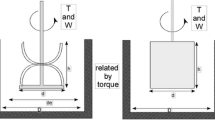Abstract
A motionless mixer consists of a straight pipe or transfer tube containing the mixing elements that are used to cut, fold, twist, and re-combine the mixing fluid. The number of elements and their shape required in any application depend on the complexity of the mixing process. The objectives of this study are to develop new motionless mixers and to perform the experimental investigation of pressure drop in order to evaluate the performance of the new ones. Glycerin is used as a mixing fluid. Pressure drop is measured using a hydraulic manometer and correlations of friction factor are proposed as a function of Re. The friction factors of Sulzer SMX mixer are in qualitative good agreement with the published data. On the average, the friction factors of SSC and YNU mixers are about 36% lower than and 6% higher than that of the Sulzer one.
Similar content being viewed by others
Abbreviations
- D:
-
Mixer diameter
- f:
-
Friction factor
- L:
-
Total length of mixer
- ΔP:
-
Pressure drop
- Re:
-
Reynolds number
- v:
-
Velocity
- Z:
-
Pressure drop correlation factor
- ρ:
-
Density
- μ:
-
Viscosity
- ε:
-
Void fraction of mixer element
- et:
-
Empty tube
- sm:
-
Motionless mixer
References
Bauman, I., 2001, “Solid-Solid Mixing with Static Mixers,”Chem. Biochem. Eng. Vol. 15, No. 4, pp. 159–165.
Chandra, K. G. and Kale, D. D.. 1992, “Pressure Drop for Laminar Flow of Viscoelastic Fluids in Static Mixers,”Chem. Eng. Sci., Vol. 47, pp. 2097–2100.
Cybulski, A. and Werner, K., 1986, “Static Mixers-Criteria for Applications and Selection,”Int. Chem. Eng., Vol. 26, pp. 171–180.
Hobbs, D. M., 1997, “Characterization of a Kenics Static Mixer Under Laminar Flow Conditions, ” Ph. D Thesis, The State University of NewJersey.
Jaffer, S.A. and Wood, P.E., 1998, “Quantification of Laminar Mixing in the Kenics Static Mixer: An Experimental Study,”The Canadian J. of Chem. Eng. Vol. 76, pp. 516–521.
Kalbitz, H., 1990. “Effect of Static Mixer on the Flow, Heat Transfer and Pressure Drop in Tube Heat Exchanger,” Ph. D Thesis of University of Braunschweig (TU), Braunschweig, Germany.
Li, H. Z., Fasol, C. H. and Choplin, L., 1996, “Hydrodynamics and Heat Transfer of Rheologically Complex Fluids in a Sulzer SMX Static Mixer,”Chem. Eng. Sci. Vol. 51, No. 10, pp. 1947–1955.
Myers, K.J., Bakker, A. and Ryan, D., 1997, “Avoid Agitation by Selecting Static Mixers,”Chem. Eng. Prog. Vol. 93, No. 6, pp. 28–38.
Pahl, M. H. and Muschelknautz, E., 1982, “Static Mixers and Their Application,”Int. Chem. Eng. Vol. 22, No. 2, pp. 197–205.
Rauline, D, Tanguy, P. A., Belvec, J. L. and Bousquet, J., 1998, “Numerical Investigation of the Performance of Several Static Mixers,”The Canadian J. of Chem. Eng. Vol. 76, pp. 527–535.
Shah, N. F. and Kale, D.D., 1991, “Pressure Drop for Laminar Flow of Non-Newtonian Fluids in Static Mixers,”Chem. Eng. Sci., Vol. 46, pp. 2159–2161.
Sir, J. and Leejaks, Z, 1982, “Pressure Drop and Homogenization Efficiency of a Motionless Mixer,”Chem. Eng. Commun. Vol. 16, pp. 325–334.
Author information
Authors and Affiliations
Corresponding author
Rights and permissions
About this article
Cite this article
Yang, H.C., Park, S.K. Pressure drop in motionless mixers. KSME International Journal 18, 526–532 (2004). https://doi.org/10.1007/BF02996117
Received:
Revised:
Published:
Issue Date:
DOI: https://doi.org/10.1007/BF02996117




